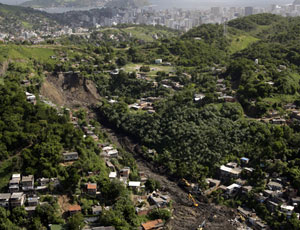In April, floods and mudslides killed 249 people in Rio de Janeiro and the outlying metropolitan area, according to fire department officials. Even in a country accustomed to heavy rainfall, flash floods and mudslides, the loss of life was unprecendented, according to Brazilian reports.

Niterói city had the highest toll: 164 dead, many of whom were killede in slides. Forty-eight bodies have been recovered.
In Niterói's Morro do Bumba district, houses were built illegally on top of a garbage dump that was supposed to have been shut down 15 years ago. Instead of banning construction, public authorities made improvements to the favela, opened streets and installed public equipment, stimulating the construction of more illegal houses.
A 2004 government-ordered study, prepared by the Geosciences Institute of the Federal University of Rio de Janeiro, warned there were 142 geotechnically problematic spots in 11 areas in Rio de Janeiro. Five of these high-risk zones were hit by the recent slides. The institute specified Morro do Bumba as a high-risk area and recommended monitoring, closure and then deactivation. No one was forced to vacate Morro do Bumba; to make matters worse, Niterói and São Gonçalo continued to dump garbage there for years.
The Geosciences Institute of the University of Brasília cites a number of factors that make flood-related disasters likely, if not inevitable: poor urban planning, clearing of natural vegetation from hilltops, and lack of inspection and control by the public administration.
Brazil, according to that institute, has comprehensive technical knowledge of the risks caused by the occupation of the hills. County, state and federal governments are equally culpable, says the institute.
The budget criteria used by the National Dept. of Civil Defense underscores the absence of accountability. Invariably, decisions are driven more by politics than by technical information. Clearly, Brazil is not preparing itself to adapt to the climatic changes occurring in the world.
The tragedy finally has forced the state government of Rio de Janeiro to remove the houses at Morro do Bumba, although it has not provided a place to go for the people who lived there.
Several remedial measures are possible after the houses are removed. The garbage dump can be stabilized, with retaining walls anchored to solid ground. Proper drainage systems would prevent water saturation of the soil. Reforestation of the hillsides would stem erosion. All the steps, if properly applied, could make things better for the future, but that is little comfort to the friends and families of those who died in April.


Post a comment to this article
Report Abusive Comment